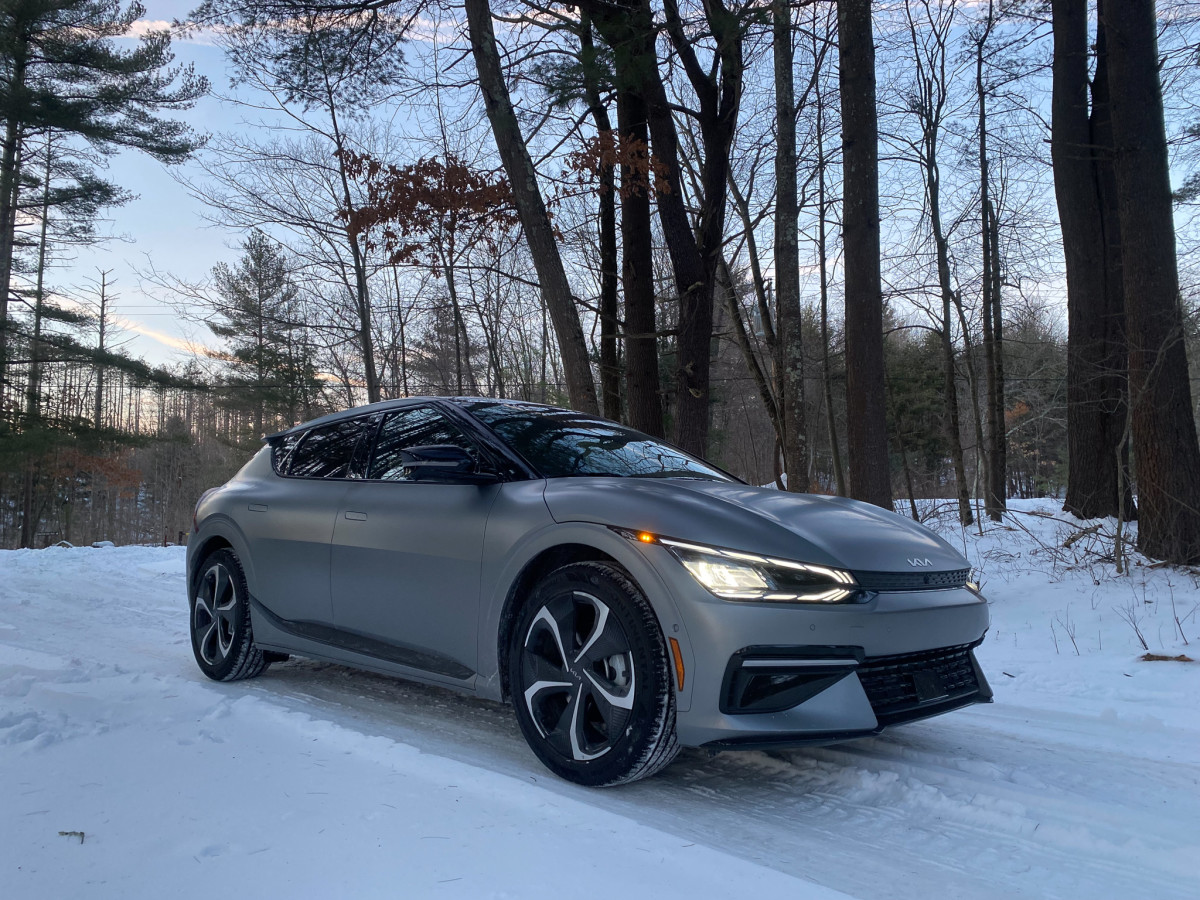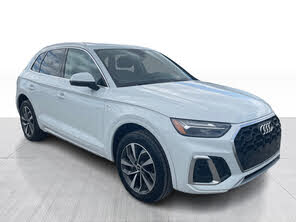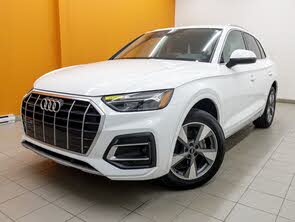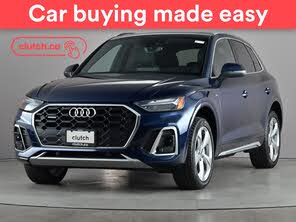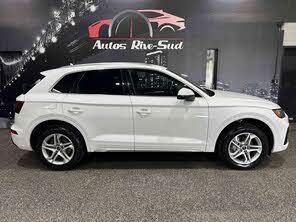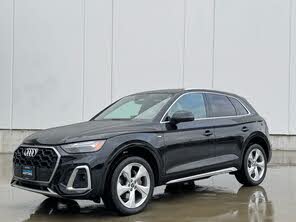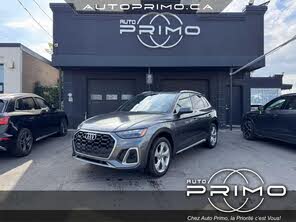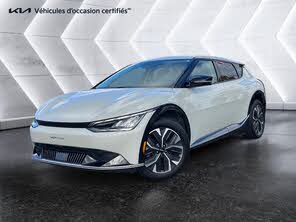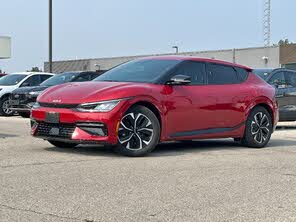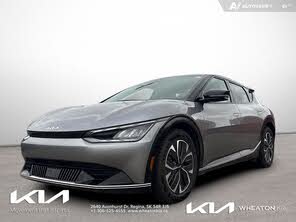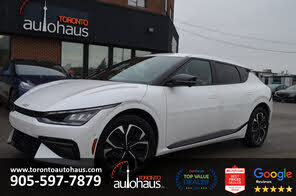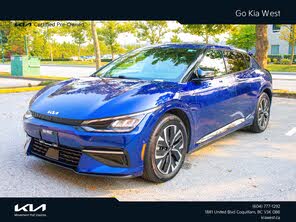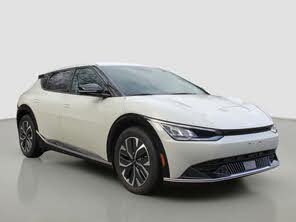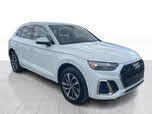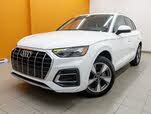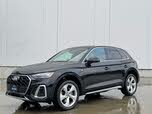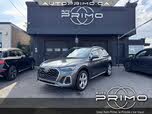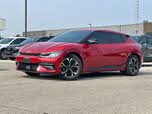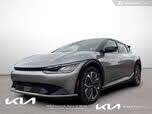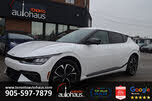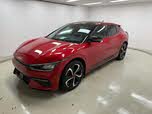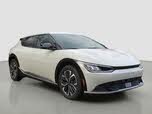2021 Audi Q5 vs 2022 Kia EV6
Overview | |
MSRP$43,300 | MSRP$40,900 |
Listings89 | Listings16 |
Ratings & Reviews | |
User Reviews | User Reviews |
Expert reviews8.0 out of 10 | Expert reviews7.7 out of 10 |
2021 Audi Q5 Reviews SummaryAudi has made a commitment to electrification across its lineup. That takes the form of all-electric (BEV), hybrid (HEV), and plug-in hybrid vehicles (PHEV). The Q5, which entered its second generation in the 2018 model year, has offered a PHEV powertrain since 2020 in the Audi Q5 TFSI e quattro. | |
2022 Kia EV6 Reviews SummaryWe didn't expect them to go there. But the designers and engineers behind the 2022 Kia EV6 did—and deleted the template of their company's affordable, cost-conscious brand. This is an electric performance car that can genuinely compete with a Tesla Model 3 on everything from tech to style to acceleration to charging time. It's a masterclass of fresh thinking in a market segment dominated by rehashed ideas. And yet, it's hampered by the same major problems that, for decades, remain unresolved. The EV6 would be amazing with battery technology that hasn't yet been invented. For now, we'll tell you what the present life is like with this most unusual and exciting Kia in years. | |
No video found | |
Popular Features & Specs | |
Engine | Engine167 hp Electric |
Drive Train | Drive TrainRWD |
Seating Capacity5 | Seating Capacity5 |
EV Battery Capacity | EV Battery Capacity58 kWh |
MPG City | MPG City136 |
MPG Highway | MPG Highway100 |
Battery Charge Time (120V) | Battery Charge Time (120V)51 hours |
Engine | |
Engine Name2.0L 261 hp I4 | Engine Name167 hp Electric |
Torque273 lb-ft @ 1600 rpm | Torque |
Horsepower261 hp @ 5250 rpm | Horsepower |
Battery Charge Time (120V) | Battery Charge Time (120V)51 hours |
DrivetrainAWD | DrivetrainRWD |
Fuel Economy | |
EV Battery Capacity | EV Battery Capacity58 kWh |
MPG City | MPG City136 |
MPG Highway | MPG Highway100 |
Interior | |
Leather SeatsStandard | Leather Seats |
Seating Capacity5 | Seating Capacity5 |
Key Features | |
Navigation System | Navigation SystemStandard |
Safety | |
Front Crash Overall5 | Front Crash Overall5 |
Side Crash Overall5 | Side Crash Overall5 |
Dimensions & Capacity | |
Cargo Space25.9 cu ft | Cargo Space24.4 cu ft |
Curb Weight4079 lbs | Curb Weight4017 lbs |
Height65.5 in | Height60.8 in |
Length184.3 in | Length184.3 in |
Width84.2 in | Width74.0 in |
Wheelbase111.0 in | Wheelbase114.2 in |
Maximum Payload1036 lbs | Maximum Payload987 lbs |
Number of doors4 | Number of doors4 |
Maximum Towing Capacity4400 lbs | Maximum Towing Capacity |
Overview | ||
MSRP | $43,300 | $40,900 |
Listings | ||
Ratings & Reviews | ||
User reviews | ||
Expert reviews | 8.0 out of 10Read full review | 7.7 out of 10Read full review |
Pros & cons | ||
Summary | Audi has made a commitment to electrification across its lineup. That takes the form of all-electric (BEV), hybrid (HEV), and plug-in hybrid vehicles (PHEV). The Q5, which entered its second generation in the 2018 model year, has offered a PHEV powertrain since 2020 in the Audi Q5 TFSI e quattro. | We didn't expect them to go there. But the designers and engineers behind the 2022 Kia EV6 did—and deleted the template of their company's affordable, cost-conscious brand. This is an electric performance car that can genuinely compete with a Tesla Model 3 on everything from tech to style to acceleration to charging time. It's a masterclass of fresh thinking in a market segment dominated by rehashed ideas. And yet, it's hampered by the same major problems that, for decades, remain unresolved. The EV6 would be amazing with battery technology that hasn't yet been invented. For now, we'll tell you what the present life is like with this most unusual and exciting Kia in years. |
Video | No video found | |
Popular Features & Specs | ||
Engine | 167 hp Electric | |
Drive Train | RWD | |
Seating Capacity | 5 | 5 |
EV Battery Capacity | 58 kWh | |
MPG City | 136 | |
MPG Highway | 100 | |
Battery Charge Time (120V) | 51 hours | |
Engine | ||
Engine Name | 2.0L 261 hp I4 | 167 hp Electric |
Torque | 273 lb-ft @ 1600 rpm | |
Horsepower | 261 hp @ 5250 rpm | |
Battery Charge Time (120V) | 51 hours | |
Drivetrain | AWD | RWD |
Fuel Economy | ||
EV Battery Capacity | 58 kWh | |
MPG City | 136 | |
MPG Highway | 100 | |
Interior | ||
Leather Seats | Standard | |
Seating Capacity | 5 | 5 |
Key Features | ||
Navigation System | Standard | |
Safety | ||
Front Crash Overall | 5 | 5 |
Side Crash Overall | 5 | 5 |
Dimensions & Capacity | ||
Cargo Space | 25.9 cu ft | 24.4 cu ft |
Curb Weight | 4079 lbs | 4017 lbs |
Height | 65.5 in | 60.8 in |
Length | 184.3 in | 184.3 in |
Width | 84.2 in | 74.0 in |
Wheelbase | 111.0 in | 114.2 in |
Maximum Payload | 1036 lbs | 987 lbs |
Number of doors | 4 | 4 |
Maximum Towing Capacity | 4400 lbs | |
The 2021 Audi Q5 was a sharp-looking crossover SUV that embodied the Audi design language while maintaining its unique character. It featured an expressive front with LED headlights flanking the prominent Audi Singleframe grille, emphasizing width with horizontal elements. The body showcased crisp character lines, and the greenhouse resembled a protective shell. The rear was marked by bold, large taillights, contributing to the Q5's classy and modern appearance. The plug-in hybrid version sported S-Line trim pieces and enhancements, including standard 19-inch wheels or optional 20-inch wheels, further elevating its aesthetic appeal. Inside, the Q5 maintained a classy and modern vibe, with technology integrated into an uncluttered design. The materials used were authentic, with real wood and metal, and the 10.1-inch touchscreen was strategically placed for optimal driver visibility. The second row was well-appointed, featuring standard leather upholstery.
The 2022 Kia EV6 presented a sportier and more svelte design compared to its competitors. It was visually lower and wider, with a highback tail featuring a lip spoiler that doubled as a lightbar. The wheels were pushed to the chassis's corners, giving the body a hipped appearance reminiscent of a Porsche 911. The headlights traced a V-shaped pattern, and the wedgy profile was accentuated by an angled roofline and twin ducts in the rear spoiler. The EV6's interior boasted dual 12-inch screens on a linear dash, a floating centre console, and seats covered in suede and leather. Ambient lighting flowed around the dash, and the digital controls and hockey-puck shifter added to its futuristic appeal. The EV6 was designed to be car-first, computer-second, making it an enjoyable drive.

















The 2021 Audi Q5 PHEV enhanced the driving experience by adding 114 horsepower and 96 pound-feet of torque with a 14.1-kWh battery, resulting in a total combined output of 362 hp and 373 lb-ft of torque. This setup, paired with a 2.0-litre turbocharged inline four-cylinder gasoline engine, allowed the Q5 to accelerate from 0 to 100 km/h in 5.3 seconds. The PHEV offered impressive fuel efficiency, with 4.7 litres-equivalent per 100 kilometres combined. The battery could be recharged overnight with household current or in 2.4 hours with Level 2 service. The Q5 featured a seven-speed S Tronic automatic transmission with full-time Quattro AWD and offered various driving modes, including battery-only and hybrid modes. The handling was good, with minimal body roll and powerful braking.
The 2022 Kia EV6, tested in the GT-Line e-AWD configuration, delivered 320 horsepower and 446 pound-feet of torque from its dual electric motors. With a 77.4 kWh battery, it accelerated to 60 mph in 4.6 seconds and handled corners with agility. The upcoming GT trim promised 576 hp and a 0-60 time of less than 3.5 seconds. The EV6's torque was effectively routed, providing seamless power delivery. The regenerative braking system offered more than eight settings, allowing for one-pedal driving in the maximum I-Pedal setting. However, the EV6's driving range was disappointing in cold weather, achieving only 65 percent of Kia's 441-kilometre estimate. Charging was efficient, with the EV6 accepting up to 240 kW, though real-world charging times were longer than Kia's claims.
The 2021 Audi Q5 offered a balanced size, with 710 litres of cargo space behind the second row and 1,503 litres with the seats folded. The second row provided reasonable legroom (960 mm) and ample headroom (958 mm) and shoulder room (1,435 mm). The front seats were comfortable and supportive, with heating and optional ventilation. The interior featured smartly laid-out storage options, including cupholders and cubbies.
The 2022 Kia EV6 reinvented core functions, such as door handles and climate controls. The interior provided generous legroom and headroom, with reclining rear seats and optional heated cushions. However, the cargo space was limited, with 690 litres behind the seats and 1,322 litres when folded. The RWD models offered a small front trunk, while the AWD models had an electric motor occupying the space. The EV6 had a towing capacity of 1,043 kilograms and an onboard power generator for 120-volt equipment.
The 2021 Audi Q5 featured a 10.1-inch touchscreen infotainment system and a 12.3-inch Audi Virtual Cockpit Plus instrument cluster with customizable views. The Bang & Olufsen 3D audio system with 19 speakers was standard, along with wireless Apple CarPlay and wired Android Auto.
The 2022 Kia EV6's infotainment system was user-friendly, though it required a wired connection for Apple CarPlay and Android Auto. The instrument panel displayed live feeds of blind spots and offered a 360-degree surround-view camera system. The head-up display used augmented reality for navigation and adaptive cruise control. The GT-Line Package 2 included a 14-speaker Meridian stereo and a remote parking assist system.
The 2021 Audi Q5 PHEV had not been rated by the IIHS or NHTSA, but the gasoline model received top ratings. Safety features included six airbags, electronic stability control, and available driver-assistance features like Audi Pre Sense front and adaptive cruise control.
The 2022 Kia EV6 had no published test results but offered standard safety features like forward collision avoidance assist and lane keep assist. Higher trims included blind spot monitoring and 360 cameras.
CarGurus highlights

According to CarGurus experts, the overall rating for the 2021 Audi Q5 is 8.0 out of 10, while the 2022 Kia EV6 scores 7.7 out of 10. Based on these ratings, the 2021 Audi Q5 is the recommended choice for those seeking a luxurious and efficient crossover with a well-rounded performance and interior.
Choose the 2021 Audi Q5 if:
- You prioritize a luxurious and well-crafted interior with high-quality materials.
- You value a plug-in hybrid with impressive fuel efficiency and driving modes.
- You need ample cargo space and comfortable seating for passengers.
Choose the 2022 Kia EV6 if:
- You prefer a sportier, more futuristic design with advanced technology features.
- You want an electric vehicle with quick acceleration and agile handling.
- You appreciate innovative interior features and generous passenger space.
CarGurus highlights

According to CarGurus experts, the overall rating for the 2021 Audi Q5 is 8.0 out of 10, while the 2022 Kia EV6 scores 7.7 out of 10. Based on these ratings, the 2021 Audi Q5 is the recommended choice for those seeking a luxurious and efficient crossover with a well-rounded performance and interior.
Choose the 2021 Audi Q5 if:
Shop Now- You prioritize a luxurious and well-crafted interior with high-quality materials.
- You value a plug-in hybrid with impressive fuel efficiency and driving modes.
- You need ample cargo space and comfortable seating for passengers.
Choose the 2022 Kia EV6 if:
Shop Now- You prefer a sportier, more futuristic design with advanced technology features.
- You want an electric vehicle with quick acceleration and agile handling.
- You appreciate innovative interior features and generous passenger space.

By: CarGurus + AI
At CarGurus, our team of experienced automotive writers remain at the heart of our content operation, conducting hands-on car tests and writing insightful guides that are backed by years of industry experience. To complement this, we are harnessing AI to make our content offering more diverse and more helpful to shoppers than ever. To achieve this, our AI systems are based exclusively on CarGurus content, ratings and data, so that what we produce is both unique to CarGurus, and uniquely helpful to car shoppers.
